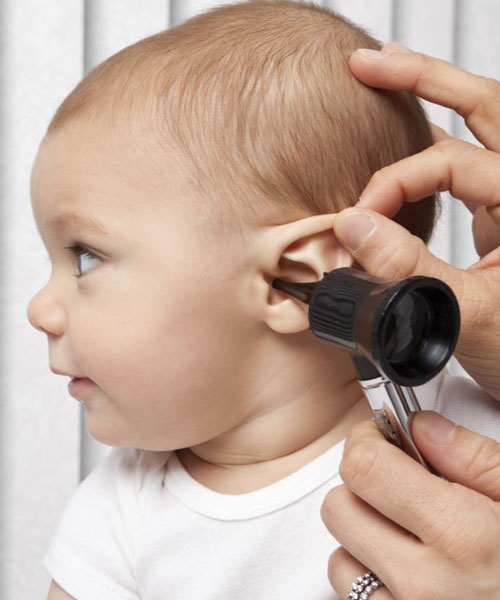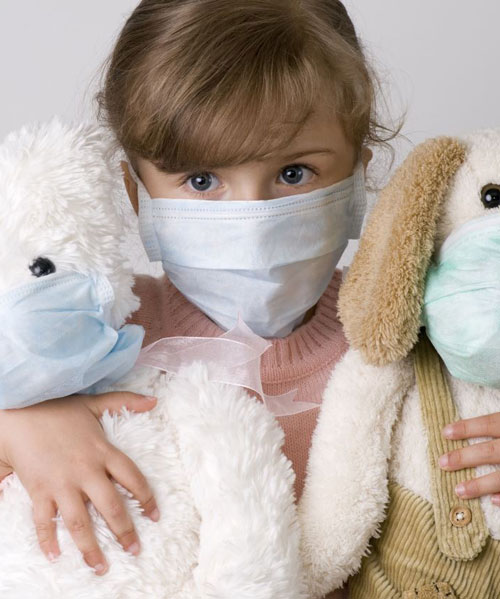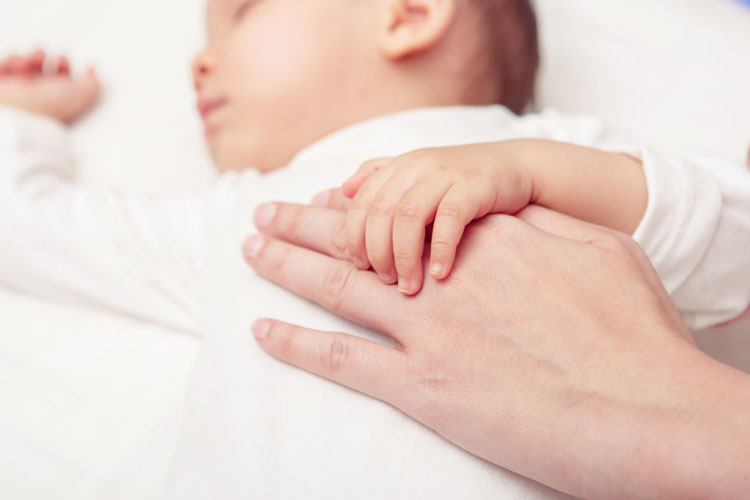This information is about the common symptoms and infections of the ear, nose, throat and chest in children who are usually healthy.
It does not apply to:
- Children who have chronic conditions such as asthma, heart or kidney diseases, etc. OR,
- Babies younger than three months as they can have a different response to infection.
Consult your doctor if your child falls into any of these categories.
No guide can be complete. If you are still worried about your child after reading this information, please seek advice from your paediatrician.

EARACHE
Pain in the ear may indicate an ear infection. Ear infections often come after a cold. Your child may also have fever.
What can I do about it?
Paracetamol or ibuprofen is the recommended treatment for pain and fever associated with most ear infections.
You can help your child feel better by:
- Giving them paracetamol and/or ibuprofen to relieve their pain and fever if they are irritable or uncomfortable
Making sure they get plenty of rest.
How long will the earache last?
- Within three days, five out of 10 children will no longer have an earache.5
- Within seven days, nine out of 10 children will no longer have an earache.5
What about antibiotics?
Children who do not have systemic symptoms are likely to have a good outcome, so initial antibiotic therapy rarely provides benefit. Children who were not given antibiotics get better just as quickly as those that take them8.
Your child is more likely to benefit from antibiotics if they:
- Are younger than two years of age, with infections in both ears8
- Have fluid leaking from their sore ear9
- Have systemic features (e.g. a high fever, lethargy, vomiting)9
Seek help
- If the earache gets worse or does not get better after two or three days9
- If your child has persistent hearing problems.
CROUP
Croup is a viral infection which causes swelling in the voice box and upper airway. This swelling makes the airway narrower and results in cough that sounds like a bark. It most commonly occurs in children under three years old. Croup is usually worse at night when the air is cooler.
What can I do about it?
You can help your child feel better by:
- Comforting and holding your child to keep them calm, as breathing is often more difficult for children when they are upset.
- Giving them water frequently to prevent dehydration.
- Sitting them up, which may help to relieve coughing.
How long will it last?
- For most children, croup will last for two days, although it can last as long as a week.10
What about antibiotics?
Antibiotics do not work on viruses and must not be given to children with croup.
Seek help
Your child should see a doctor urgently if:
- They have noisy breathing (stridor)
- They struggle to breathe
- The muscles around their ribs are visibly sucked in with each breath
- They are very distressed, bluish grey or pale
- They cannot swallow or are drooling more than usual.

BRONCHIOLITIS
Bronchiolitis is a viral infection of the bronchioles (the small airways in the lungs).
Viral bronchiolitis commonly occurs in children under two years of age. It is one of the most common reasons for hospitalisation in children under six months.
What can I do about it?
You can help your child feel better by:
- Keeping your child at home from day care; bronchiolitis is infectious
- Making sure your child rests
- Giving more frequent breastfeeds (or formula or water) to avoid dehydration
- Checking on your child regularly, including during the night
- Making sure your child is in a smoke-free environment
These medicines can help you manage the symptoms of bronchiolitis:
- Paracetamol or ibuprofen, which can relieve fever.
- Saline nasal drops for relieving a blocked nose.1
How long will it last?
Bronchiolitis may worsen on the second or third day and your child might be sick for seven to 10 days. The cough may continue for two to four weeks.11
What about antibiotics?
Antibiotics must not be given because bronchiolitis is caused by a virus.
Seek help
Your child should see a doctor urgently if:
- They have difficulty breathing (the muscles around their ribs are visibly sucked in with each breath)
- They have less than half their normal feeds or refuse to eat or drink
- They become agitated, exhausted, or more sleepy than usual

WHOOPING COUGH
Whooping cough (pertussis) is a highly contagious respiratory infection of the lungs and airways caused by bacteria called Bordetella pertussis.
Whooping cough usually starts with cold-like symptoms, and develops into a cough. Intense coughing bouts start about a week later and may last for many weeks. The cough comes in long spells and often ends with a high pitched “whoop” sound when they breathe in.
If you suspect your child has whooping cough, see your doctor.
What can I do about it?
You can help your child feel better by:
- Giving them smaller meals and portions of fluids, more often.13
- Keeping your home free of irritants such as cigarette smoke.1
- Keeping your child at home for three weeks from the start of the cough (if no antibiotics are given) or until they have had at least five days of their course of antibiotics.13
How long will it last?
Whooping cough may last up to six weeks, with an ongoing cough lasting another two to six weeks.14
What about antibiotics?
Antibiotics may be prescribed during the first three weeks of infection. This helps stop the infection spreading to others, but may not reduce the symptoms. If the cough has been present for longer than three weeks, antibiotics are unlikely to help as the child is no longer contagious.13
Seek help
- If your child has difficulty breathing.
- If your child has problems catching their breath after a coughing spasm.
WHY ARE ANTIBIOTICS UNSUITABLE?
Most of these types of symptoms and infections are self-limiting, which means they will resolve without treatment. Colds and most coughs are caused by viruses and antibiotics are not active against viral infections.
There are several reasons why antibiotics should not be administered unless necessary:
- Inappropriate use and overuse of antibiotics makes bacteria resistant to antibiotics, which means antibiotics no longer work against bacterial infections. People with recent antibiotics use have increased risk of developing resistant bacteria in their body. Certain bacterial strains have become resistant to even the most powerful antibiotics available today.
- Unnecessary use of antibiotics means that they won’t work in the future when they are needed, especially for serious or life-threatening infections.
- Antibiotics kill many different bacteria, even the good ones that help keep the body healthy. This can result in diarrhoea and infections such as thrush.
- Antibiotics may also cause allergic reactions. These are often just annoying rashes, but can, in some cases, be severe reactions.
If your child gets an antibiotic-resistant bacterial infection:
- They will suffer the infection for longer
- They may be more likely to develop complications due to the infection
- They could remain infectious for longer, and pass the infection to other people, which could threaten the community.
When might my child need antibiotics?
Most upper respiratory tract infections are caused by viruses and require no antibiotics.15
However, there are some situations when your doctor may decide your child may need to take antibiotics. Examples include:
- An earache with fluid coming from both ears1
- A cough that is suspected or found to be whooping cough (pertussis) or bacterial pneumonia.

When should I seek further help?
No guide is complete. If you are still worried about your child after reading this information, then you should seek advice from your doctor. If you feel that it is an emergency, call for an ambulance.
Signs of possible serious illness:
- Your child is drowsy or distressed and does not improve after treatment with paracetamol and/or ibuprofen. If they are very drowsy, you should take them to see a doctor immediately.
- Your child has difficulty breathing – including rapid breathing, shortness of breath or ‘struggling’ to breathe (the chest sinks in with each breath, especially around the collarbone and around the ribs.). Any child who has a lot of difficulty breathing needs to see a doctor urgently.
- Your child has a convulsion.1
- You notice unusual skin colouring (pale, blue) around your child’s eyes, lips, hands, and feet, especially the nail beds.
- A temperature ≥ 39° C in a child aged three to six months of age (an infant who is less than three months of age should be assessed if they have a temperature ≥ 38° C).1
- Most children can go a few days without eating much. However an infant who is not feeding or any child that is showing signs of dehydration, such as a dry mouth and lips, sunken eyes, sunken fontanelle, an inability to shed tears or urinate should be assessed. This is particularly true for young children (under one year) and those who are vomiting.
- Your child is unable to swallow, is drooling more than usual and looking generally unwell.
- Your child shows symptoms suggesting meningitis: unusually severe headache, stiff neck in older children (difficulty putting chin to chest), dislike of bright lights (photophobia), seizures, non-blanching rash (the rash doesn’t disappear when you place a drinking glass to the skin.1
Other symptoms that indicate you should take your child to see a doctor
- A cough that hasn’t improved in three weeks (or sooner if the child becomes breathless easily or there is a family history of asthma).
- Any fever lasting five days or more.2
- Persistent hearing problems.
References:
1. https://www.nps.org.au/medical-info/consumer-info/coughs-colds-earaches-and-sore-throats-a-guide-for-parents-and-carers
2. National Institute for Health and Care Excellence (NICE). Fever in under 5s: assessment and initial management (CG160). Updated Aug 2017. [Online] (accessed Dec 2017)
3. Royal Children’s Hospital Melbourne. Fever in children. RCH fact sheet. Updated Sep 2011. [Online] (accessed Dec 2017)
4. Royal Children’s Hospital Melbourne. Viral illnesses. RCH fact sheet. Updated Dec 2010. [Online] (accessed Dec 2017)
5. Thompson M, Vodicka TA, Blair PS, et al. Duration of symptoms of respiratory tract infections in children: systematic review. BMJ 2013;347;f7027. [PubMed].
6. Spinks A, Glasziou PP, Del Mar CB. Antibiotics for sore throat. Cochrane Database Syst Rev 2013. [PubMed].
7. Kenealy T, Arroll B. Antibiotics for the common cold and acute purulent rhinitis. Cochrane Database Syst Rev 2013:Cd000247. [PubMed].
8. Venekamp RP, Sanders S, Glasziou PP, et al. Antibiotics for acute otitis media in children. Cochrane Database Syst Rev 2015(6):CD000219. [PubMed].
9. Antibiotic Expert Group. Antibiotic Therapeutic Guidelines v15. Therapeutic Guidelines Pty Ltd. [eTG Online] (accessed Dec 2017).
10. Johnson DW. Croup. BMJ Clinical Evidence 2014;2014:0321. [PubMed].
11. Royal Children’s Hospital Melbourne. Brochiolitis. Kids Health Info. 2008. [Online] (accessed Dec 2017).
12. Centres for Disease Control and Prevention. Pertussis (whooping cough). National Centre for Immunization and Respiratory Diseases, Division of Bacterial Diseases 2015. [Online] (accessed Dec 2017).
13. Royal Children’s Hospital Melbourne. Whooping cough. Kids Health Info. 2008. [Online] (accessed Dec 2017).
14. Centres for Disease Control and Prevention. Pertussis (whooping cough). National Centre for Immunisation and Respiratory Diseases, Division of Bacterial Diseases 2015. [Online] (accessed Dec 2017).
15. Hersh AL, Jackson MA, Hicks LA, et al. Principles of judicious antibiotic prescribing for upper respiratory tract infections in paediatrics. Paediatrics 2013;132:1146-54. [PubMed].



